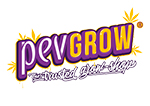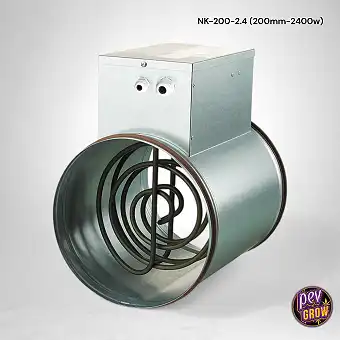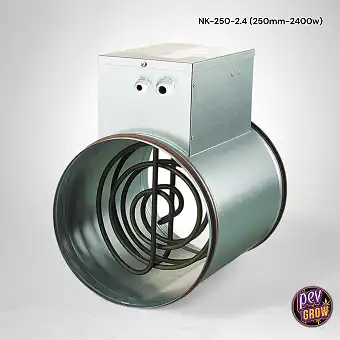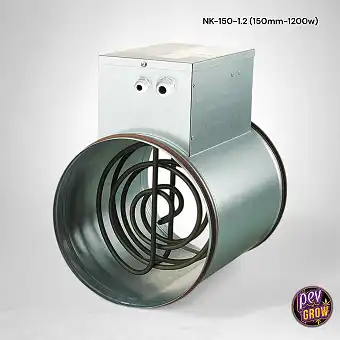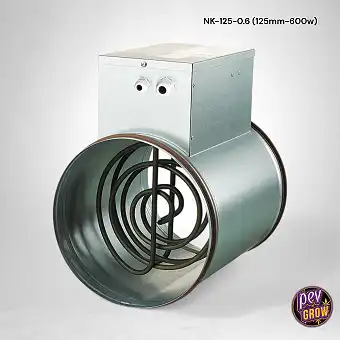Ducted Heating
Ducted heating distributes warm air evenly, stabilizing the temperature of your room or closet and improving the metabolism of the plants. When integrated with climate control and proper ventilation, it reduces condensation, mold, and growth stoppages.
At Pevgrow, you can set up a complete system by combining duct heater, extraction and ventilation, air extractors, and sensors. This way, you achieve a stable, efficient, and quiet cultivation throughout the cycle.
Duct Heating: uniform and efficient thermal control for your indoor
Duct heating is the most stable and professional method for distributing heat in an indoor cultivation. Unlike spot heaters, a ducted system pushes air through ducts to multiple outlets, correcting thermal stratifications, avoiding “hot spots,” and reducing vegetative stress. When properly sized, it integrates with the ventilation system, extractors, and humidity management to maintain an optimal microclimate, key for the performance and health of the crop.
How does a duct heating system work?
The heart of the system is a duct heater installed in the supply line; hot air circulates through flexible or rigid tubes to strategic outlets. A thermal controller modulates the power to maintain a target range —for example, 22–26 °C during growth and 20–24 °C during flowering— while extraction and intake renew the air and balance pressures. The result is a uniform distribution of heat without aggressive drafts, perfect for grow tents or rooms with different canopy heights.
Key advantages over spot heaters
- Thermal homogeneity: fewer gradients and less stress for roots and young leaves.
- Energy efficiency: by heating the driven flow, the system requires fewer ON/OFF cycles.
- Less condensation: by stabilizing air temperature, the “dew point” is reduced.
- Scalability: add outlets or branches as the project grows.
- Odor integration: works together with carbon filters for a discreet environment.
Sizing guide: flow rate, power, and outlets
To size your duct heating, calculate the volume of the room (m³) and define the desired thermal jump (ΔT). From there, the power of the heater is selected based on insulation and losses; the airflow must match the power to avoid local overheating. The rule of thumb: several smaller supply outlets distributed at different heights perform better than a single large outlet in the center. Complement with a reliable thermo-hygrometer to record the actual stability of the system.
Integration with ventilation, humidity, and safety
Heat without ventilation is a classic mistake. Maintain a line of fresh air and another hot to avoid recirculation of stale air; a good system relies on properly sized air extractors, fans that move the boundary layer of the leaves, and well-sealed ventilation ducts. Additionally, regulate relative humidity with humidifiers during growth and dehumidifiers during advanced flowering to prevent botrytis.
Recommended installation (step by step)
- Plan layout: define the path of supply and locate the outlets in different areas of the canopy.
- Locate the heater: in a straight line behind the blower, with bypass or flaps if working with multiple branches.
- Seal everything: use clamps and aluminum tape on joints to avoid leaks and losses.
- Control the climate: link the heater to a thermostat and record with a thermo-hygrometer at canopy height.
- Anti-odor and renewal: combine with a carbon filter in the extraction line to maintain discretion.
Purchase checklist
- Power and flow rate: that cover the volume and thermal loss of your space.
- Ducts and insulation: prioritize short paths and wide bends to avoid strangling the flow.
- Compatibility: check diameters with your extractor and the existing branch.
- Control: integrate with the climate control ecosystem you already use.
- Future expansion: leave blind ports to add new outlets if you expand cultivation.
FAQ — Frequently Asked Questions
- Can I use duct heating in small grow tents?
- Yes, as long as the flow rate and power are adjusted to the volume; in small spaces, prioritize short branches and well-oriented outlets to the canopy.
- Does duct heating increase consumption?
- Consumption depends on insulation and setpoint. By distributing heat better, the system requires fewer power peaks than a poorly oriented spot heater.
- How do I avoid excess humidity when heating?
- Synchronize ventilation and RH control: use a humidifier or dehumidifier according to phase and leaf density.
- What maintenance does it require?
- Check joints, clean the filter if your model includes one, and check probes/thermostats each cycle. Keep extractors and fans free of dust.
- How to reduce noise?
- Use flexible sleeves, straight paths, and silencers. Choose oversized ventilation equipment to operate at lower RPM.
Conclusion
A well-designed duct heating system turns the climate of your cultivation into a competitive advantage: stable temperatures, fewer diseases, and faster development. Integrate heater, ventilation, carbon filters, and monitoring to achieve consistent, quiet, and efficient harvests; with Pevgrow's catalog, you can build it in phases and scale it without surprises.
Among all of you who comment or send us your questions there will be a bimonthly draw for a 50 euros voucher to buy in Pevgrow. What are you waiting for? Write now and participate!


